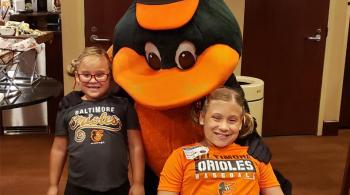 We are social creatures by nature, experts say. But navigating the search for real human connection can be as painful as it can be rewarding. The skills needed to develop friends—to find one’s own tribe outside the family unit—are not always in abundance. They must be taught, practiced and rewarded as a child grows. The responsibility for this training usually falls upon the parents.
We are social creatures by nature, experts say. But navigating the search for real human connection can be as painful as it can be rewarding. The skills needed to develop friends—to find one’s own tribe outside the family unit—are not always in abundance. They must be taught, practiced and rewarded as a child grows. The responsibility for this training usually falls upon the parents.
Belonging is the goal. A sense of belonging to a group can help lessen overall anxiety. As a child grows, the sense of belonging that starts with the family begins to extend to people outside the family. This is how that delicate transition of leaving home (physically or emotionally) takes place over time. It begins with friendships made outside the family constellation.
The lessons needed to make and be a friend are sometimes mentioned in children’s books, but they’re not always taught or modeled enough by the adults in a child’s life. Many adults assume that because kids play together, it can’t be that difficult for them to make friends. But acquiring the social skills needed to create and sustain friendships can be difficult for children, especially those with developmental disabilities.
“In the past, it was tough to make friends,” says Sheiku, a college-aged Kennedy Krieger Institute patient with cerebral palsy. Watch Sheiku below.
Recent research indicates that the ability to initiate and maintain close friendships is distinctly different from being popular (i.e., simply being liked and accepted by the group). In friendships, children and teens need to be able to carry out sophisticated—almost adult-like—social maneuvers, all while assessing the qualities of a potential friend.
Being a good friend can teach and inspire loyalty. Good friends exhibit a bit of emotional maturity when it comes to sharing both power and toys with another child. A friend is someone with whom one usually has fun. These are skills that need to be cultivated. Some young people will encounter greater difficulty in acquiring the skills needed to make friends, but most can learn. The process needs to be deliberate, and adults need to be sensitive to the dynamics involved.
The friendship frontier demands abilities in a variety of areas, including:
- Conversational and social skills
- Emotional intelligence and understanding nonverbal cues
- Choosing appropriate friends
- Appropriate use of humor
- How best to handle electronic communications
- Peer entry strategies (i.e., how to join a conversation)
- Good sportsmanship (i.e., graceful winning and losing)
- Handling teasing, bullying and gossip
- Planning successful get-togethers
- Practicing the characteristics of being a good friend
- Appreciating differences
- Sharing decision-making, resources and power
What can parents, teachers and other adults do to help kids make friends, and why is it important?
While no systematic way yet exists to teach a child to be better at friendship, much has been discovered through research. Friendships are important. For instance, adults who had friends when they were in fifth grade are more likely to have healthy family relationships and a positive outlook as adults, and are less likely to suffer from depression later in life, according to Dr. Catherine Bagwell of Colgate University.
A child’s ability to navigate through his or her social world shapes all aspects of his or her intellectual and emotional growth, adds Dr. Kenneth Rubin, co-author of the 2015 book “The Friendship Factor.” It is crucial to a child’s future happiness and success.
Sometimes, just getting a child to think through the dynamics of a situation (role playing is one way to do that) helps ready him or her for the real event. Discussing friendship concepts, like why being a generous playmate is a good idea, can be amazingly fruitful and instructive.
As parents, we can’t make friends for our children, but we can help them understand the key ingredients of a healthy friendship. Just asking what traits a child likes in a friend can help guide him or her to aspire to those traits and better prepare the child to be a better friend.
Society as a whole is beginning to recognize the friendship challenges of children with special needs. For instance, Sesame Street recently introduced a new Muppets character, Julia, who has autism spectrum disorder (ASD).
The scripts involving Julia depict specific characteristics of those diagnosed with ASD, and the story lines educate other children about specific ways to interact with a child with autism. For example, in one scene, Elmo explains that he uses fewer words and repeats himself when communicating with Julia. Sesame Street sheds light not only on the behavioral, social and communication differences of children with ASD, but also on practical communication strategies that can apply to interaction between all children.
Dr. Tiffany Born, a licensed psychologist at Kennedy Krieger’s Pediatric Developmental Disabilities Clinic, has been running 14-week specialized group sessions to teach children and teenagers with ASD the socialization skills necessary to succeed at forming friendships. Parents are enrolled in a separate class to learn how to facilitate the development of these skills. Children learn how to break down the most important basic components of being social into easy-to-do steps. Those components are:
- Starting and maintaining a conversation
- Following other people’s verbal and nonverbal cues
- Starting to like learning more about others
- Being a fun person to be with
Most children, when asked why they seek out the friendship of a particular person, say that he or she is “fun to be with.” That’s an essential element of friendship, Dr. Born points out, especially for youngsters.
“Many children on the spectrum have restricted interests and want to talk about only the topic that interests them,” she says. This can eventually be boring for those listening and can turn off potential friends. The group therapy sessions she runs for children and teens with ASD help them practice behaviors that demonstrate ways in which social conversation involves a careful balance of give and take.
“It is important for those on the autism spectrum to interact with peer models not on the spectrum,” Dr. Born adds. That’s a wonderful way, she says, to observe and practice skilled interactions.
One major myth about children and teenagers with developmental disabilities holds that they don’t want to have friends, but “nothing could be further from the truth,” Dr. Born says. The key training strategies for successful socialization training include:
- PRACTICE, particularly via role-playing situations
- IMMEDIATE REWARDS, for practicing and completing weekly homework
- FEEDBACK, both verbal (primary) and video (secondary), to show a child how his or her behavior may appear to others
Dr. Born points out that rewarding even approximations of the behaviors sought can be a powerful learning tool. Listening helps teach flexibility. Taking turns can be taught, and it benefits both parties.
But what does a child do when he or she is being teased? In the groups held at the Pediatric Developmental Disabilities Clinic, counselors instruct children to “never tease the tease.”
In other words, don’t respond to teasing with a big reaction. Instead, act as if the words are no big deal. Those who tease usually want a reaction. No reaction can result in extinguishing the teasing behavior.
Yet there are times when situations escalate. Any child can become aggressive if provoked enough, because provocation can cause anxiety, and anxiety can lead to aggression. While counselors teach explicit coping strategies, involving an adult is sometimes the best and most appropriate action when tensions are high.
It is difficult to illustrate to a child how short-term changes in socialization behavior can result in greater friendship benefits in the long term. Taking turns in conversations and in playing games can be quite difficult because the rewards for these behaviors are not immediate.
Learning to postpone immediate gratification is part of becoming a mature adult. For many children, gaining the longer-term benefits of friendship requires short-term sacrifices. There are skills that need to be learned and practiced. That is why introducing short-term rewards (e.g., tiny prizes, point systems and public praise) can help facilitate the process.
Connecting with others is an important human need. Sheiku, the college-aged Kennedy Krieger patient with cerebral palsy, closes his video with this simple and important message to other kids: “I advise: stay positive, head up, be happy. No matter what, stay connected.”
(To learn more about—or to sign up for—therapy groups for children and teenagers with ADS offered by Kennedy Krieger’s Behavioral Psychology–Pediatric Developmental Disabilities Clinic, call 443-923-7508, or call toll-free at 844-334-3211. Groups are held in the early evenings. Summer 2017 groups are forming now.)















